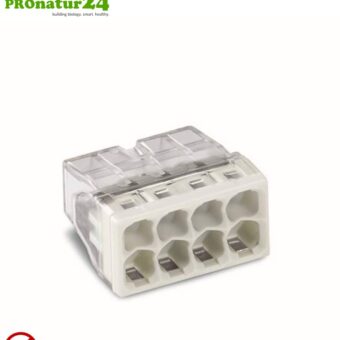ecoturbino® | SAME shower pleasure, MORE hygiene, LESS water, LESS costs, much LESS limescale
webdeals is a shop cloud. The networking of modern, specialised webshops with a thematic focus. WEBDEALS » here will be found!
€ 27,99 (€ 23,33 excl. VAT)
Compact splicing connectors from WAGO have completely convinced us. Due to their easy handling and compact design, they are simply ideal for use within our shielded installation boxes and for connecting our shielded lamps for fixed installation.
Delivery time: approx. 1-3 working days
In stock
The shielded flush-mounted box or cavity wall box contains a potential connection line. This line must be connected to the two-wire of the shielded electric cable or sheathed cable and this splicing connector (as well as the 2-conductor variant) can be used for this purpose. A simple, fast and effective solution.
Basically, the 2273-20x model series of WAGO compact splicing connector can be optimally used for all electrical wiring. Strictly speaking, the classic connector block with screw fixing has now had its day. The level of technological development in this area is now too great: plug in a solid conductor cable (“push it in”) – and that’s it! Fiddly handling with a screwdriver is history. Thanks to this simplicity, WAGO compact splicing connectors are ideal and predestined for all cable connections within the house wiring and also for connecting our shielded ceilings and wall lights.
That’s how you connect today!
CONNECT LADDER
APPLICATION

The connector can be used for up to 8 (depending on the model) solid conductors 0.5 … 2.5mm² – and without tools!
That’s how it’s done:
Removal:
Hold conductor to be removed and twist alternately left and right while pulling the connector.
Testing:
Testing via test port opposite to conductor entry.
| Weight | 0,2 kg |
|---|---|
| Dimensions | 11 × 8 × 4 cm |
| Scope of delivery | 50 pieces |
| Colour | |
| Single clamp | Width: 18 mm |
| Brand | |
| Country of origin | Germany |
| Electrical data |
|
| Ratings per IEC/EN 60664-1 | |
| Ratings per | EN 60664-1 |
| Nominal voltage (II/2) | 450 V |
| Rated surge voltage (II/2) | 4 kV |
| Rated current | 24 A |
| Legend (ratings) | (II / 2) ≙ Overvoltage category II / Pollution degree 2 |
| Connection data | |
| Connection technology | PUSH WIRE® |
| Actuation type | Push-In |
| Connectable conductor materials | Copper, Aluminum |
| Nominal cross-section | 4 mm² |
| Solid conductor | 0.5 … 2.5mm² / 24 … 12 AWG |
| Strip length | 11 mm / 0.43 inch |
| Total number of connection points | 8 |
| Total number of potentials | 1 |
| Wiring type | Side-entry wiring |
 WAGO compact splicing connector | model 2273-208 | for 8 solid conductors | conductor cross-section 0.5 to 2.5 mm² | 450V / 24 A | 50 pieces per pack
WAGO compact splicing connector | model 2273-208 | for 8 solid conductors | conductor cross-section 0.5 to 2.5 mm² | 450V / 24 A | 50 pieces per pack
Electric installation boxes
Insulating tube | for the bare drain wire from the shielded installation cable
Electric installation boxes
Electric installation boxes
Electric installation boxes
Electric installation boxes
Electric installation boxes
Electric installation boxes
We use cookies to give you the best online experience. By agreeing, you accept the use of cookies in accordance with our cookie policy. Further surfing in the web shop automatically leads to approval.

When you visit any web site, it may store or retrieve information on your browser, mostly in the form of cookies. Control your personal Cookie Services here.
Reviews
There are no reviews yet